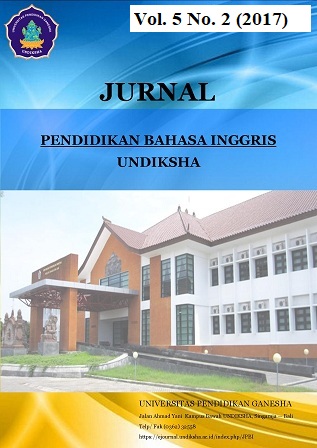THE IMPLEMENTATION OF VARIOUS GROUPING STRATEGIES IN ENGLISH CLASSES IN JUNIOR HIGH SCHOOLS IN SINGARAJA: A DESCRIPTIVE STUDY
DOI:
https://doi.org/10.23887/jpbi.v5i2.11097Abstract
Penelitian ini bertujuan untuk mendeskripsikan bagaimana strategi pengelompokan direncanakan oleh guru bahasa Inggris, bagaimana strategi tersebut diterapkan dan bagaimana persepsi siswa terhadap penerapan strategi pengelompokan di kelas bahasa Inggris. Rancangan penelitian ini adalah desain deskriptif kualitatif. Data dikumpulkan dengan menggunakan lima instrumen, antara lain observasi kelas, pedoman wawancara, dokumentasi, kuesioner dan daftar strategi pengelompokan. Subjek penelitian ini adalah tiga guru bahasa Inggris dan 99 siswa dari tiga SMP negeri yang berbeda di Bali Utara. Sekolah dipilih melalui random sampling. Hasilnya menunjukkan bahwa guru bahasa Inggris merencanakan strategi pengelompokan di kelas bahasa Inggris. Terdapat dua belas rencana pelajaran yang digunakan oleh guru di berbagai sekolah menengah pertama di Singaraja pada delapan belas kali pertemuan. Pada rencana pelajaran, guru merencanakan strategi STAD, di mana siswa dibagi menjadi kelompok yang terdiri dari empat sampai lima siswa. Kemudian, kelompok ditugaskan untuk mendiskusikan materi yang diberikan oleh guru. Berdasarkan delapan belas observasi kelas, para guru menerapkan teknik STAD, Jigsaw, Think-Pair-Share dan Team Games Tournament. Berdasarkan hasil kuesioner, ditemukan bahwa siswa memiliki persepsi positif tentang penerapan strategi pengelompokan di sekolah menengah pertama di Singaraja.Kata Kunci : Rencana Guru, Strategi Pengelompokan, Persepsi Siswa
This study aimed at describing how grouping strategies were planned by English teachers, how those strategies were implemented and how students perceived the implementation of grouping strategies in English classes. The design of this study was a descriptive qualitative one. The data were collected by using five instruments, those are, classroom observation, interview guide, documentations, questionnaire and grouping strategies checklist. The subjects of this study were the three English teachers and 99 students from three different public junior high schools in North Bali. The schools were decided through random sampling. The result showed that English teachers planned grouping strategies in English classes. There were twelve lesson plans used by teachers in different junior high schools in Singaraja on eighteen times of meetings. On lesson plans, the teacher planned STAD strategy, in which students were divided into groups of four to five students. Then, the groups were assigned to discuss material given that was by the teacher. Based on eighteen classroom observations, the teachers implemented STAD, Jigsaw, Think-Pair-Share and Team Games Tournament technique. Based on the result of questionnaire, it was found that students had positive perception about the implementation of grouping strategies in junior high schools in Singaraja.
keyword : Teachers’ Plans, Grouping Strategies, Students’ Perception
Published
2017-07-24
Issue
Section
Articles
License
Authors who publish with the Jurnal Pendidikan Bahasa Inggris Undiksha agree to the following terms:- Authors retain copyright and grant the journal the right of first publication with the work simultaneously licensed under a Creative Commons Attribution License (CC BY-SA 4.0) that allows others to share the work with an acknowledgment of the work's authorship and initial publication in this journal
- Authors are able to enter into separate, additional contractual arrangements for the non-exclusive distribution of the journal's published version of the work (e.g., post it to an institutional repository or publish it in a book), with an acknowledgment of its initial publication in this journal.
- Authors are permitted and encouraged to post their work online (e.g., in institutional repositories or on their website) prior to and during the submission process, as it can lead to productive exchanges, as well as earlier and greater citation of published work. (See The Effect of Open Access)













